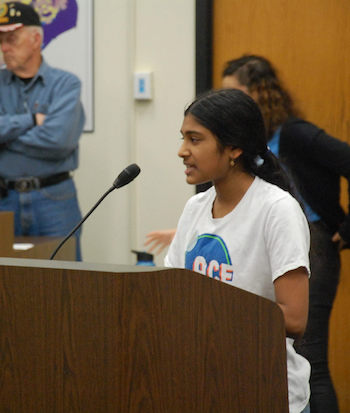Clean Power Plan’s Day in Court
Rebecca Anderson
|September 30, 2016

Youth climate activist Teja Sathi testified before EPA Administrator Gina McCarthy last year
Dozens of lawyers spent more than seven hours presenting their sides with respect to the Clean Power Plan in front of the full ten-member D.C. Circuit Court on Tuesday. After the arguments, both sides emerged exhausted, as well as confident of their chances of winning.
Notably, one thing that wasn’t debated was the scientific reality of climate change.
Arguments were heard both on the details of the case, such as if a pollutant could be regulated under two different clauses of the Clean Air Act, as well as on broad constitutional grounds, as to whether the EPA is within its authority to regulate carbon emissions at such a large scale.
Notably, one thing that wasn’t debated was the scientific reality of climate change. All justices on the court recognized the Supreme Court decision in 2007 that carbon dioxide is a pollutant that can and should be regulated under the Clean Air Act.
“I feel somewhat betwixt and between,” said one judge. On one hand, she said, the Supreme Court clearly wants the EPA to regulate carbon. But on the other, the immense changes to the utility industry that will result are so far-reaching that a “clear statement” might be necessary from Congress to truly authorize the Clean Power Plan.
What’s next? It could take up to six months for the justices to issue a ruling. As to whether either side appeals to the Supreme Court, that depends on the outcome of the presidential election, now just over a month away. If you are looking to learn more about both sides of the agrument over the Clean Power Plan, we recommend you watch this Intelligence Squared Debate.
We Support the Clean Power Plan
ACE has worked hard over the years to support the leadership of young people in fighting for policies that protect people and places from the worst impacts of climate change. We fight to stop fossil fuel infrastructure from growing. We fight to protect those most vulnerable from harmful carbon pollution. And, we fight to increase investment for, and equitable access to, renewable energy technology.
We see the Environmental Protection Agency (EPA), and its administrative power to create rules that enforce the Clean Air Act, as essential to this mission. We see the Clean Power Plan as one of the great modern successes of the EPA and its authority under the Clean Air Act. Throughout the process of bringing the Clean Power Plan to life, ACE has supported young people to testify before the EPA on its behalf, submit public comments and ensure that our leaders know how important the plan is to their future.
The stakes couldn’t be higher. The fate of President Obama’s signature climate policy, and the fate of global emissions, hang in the balance.

Unfortunately, 27 states, led by big coal producer, West Virginia, and fossil fuel industry groups, are bringing the Environmental Protection Agency’s Clean Power Plan rules before the U.S. Court of Appeals for the District of Columbia Circuit today. The Clean Power Plan is President Obama’s signature climate plan and it’s being threatened by the fossil fuel industry and their friends.
It’s no surprise that many of the states that have joined in the lawsuit are home to many fossil fuel companies, energy producers and refiners. These states argue that the EPA doesn’t have the legal authority to issue such sweeping regulation—only Congress can do that. They also argue some smaller, technical positions, namely that the EPA can’t legally regulate the same pollutant under two separate clauses of the Clean Air Act. This issue is a result of a clerical error made when Congress updated the Clean Air Act in 1990. Read more about this all-important technicality in the New York Times.
The Court’s Role
Earlier this week, the Obama administration’s historic Clean Power Plan was brought to court. This is a big deal.
It’s such a big deal that instead of a three-judge panel, as is typical, the full 11 member D.C. Circuit Court heard the arguments. However, only 10 judges took part because the court’s chief judge, Merrick Garland, recused himself from this case. Chief Judge Garland is President Obama’s nominee to replace Supreme Court Justice Antonin Scalia. Of the 10 judges who will hear the case, six were appointed by Democratic presidents.
No matter the outcome, the case will almost certainly head next to the Supreme Court. The February 13 death of conservative Justice Antonin Scalia has left the court ideologically split down the middle, with four conservatives and four liberals. A 4-4 ruling by the Supreme Court would uphold the D.C. Circuit Court ruling.
The stakes couldn’t be higher. The fate of President Obama’s signature climate policy, and the fate of global emissions, hang in the balance. Almost all of the actions that the U.S. committed to at the global climate talks in Paris last year come from the Clean Power Plan. Without it, the U.S. won’t be able to uphold its commitments to the Paris Climate Agreement and that could throw the whole agreement into disarray.
Breaking Down the Clean Power Plan
So, let’s take a step back and review what the Clean Power Plan does, as well as why it’s being fought so furiously. The Clean Power Plan would reduce carbon dioxide emissions from power plants by 32% from 2005 levels, by 2030. That’s a huge step in tackling the United States’ contribution to climate change since emissions from electric utilities, mainly coal-burning power plants, are our country’s biggest source of carbon pollution. The way the Clean Power Plan works is to give states the flexibility to come up with their own plan to reduce their emissions by transitioning away from coal, increasing energy efficiency, increasing renewable energy, and even through trading emissions permits with other states.
The plan would entirely overhaul our nation’s electricity sector, further opening the market for renewable energy technologies, like solar and wind, and in many cases would bring about an end to coal-fired power plants.
The Road Ahead
As with all big court cases, there’s no clear picture of how the judges will rule. It’s almost certain that a judgement won’t come out before President Obama leaves office on January 20. And, whether either side appeals the final decision to the Supreme Court will also depend on who becomes the next President. The EPA under a Republican President is much less likely to appeal than the EPA under a Democratic President.
Join our Youth Action Network
More Blog Posts

Our Climate Wins Were on Display at the State of the Union
Today, the Biden Administration temporarily halted all pending decisions on 17 Liquefied “Natural” Gas (LNG) projects across the Gulf South.
Read More
ACE Honored As An Anthem Awards Finalist
Action for the Climate Emergency (ACE) announced today that it won Bronze in Best Use of AI at the 3rd …
Read More
BREAKING: Biden Halts LNG Export Expansion
Today, the Biden Administration temporarily halted all pending decisions on 17 Liquefied “Natural” Gas (LNG) projects across the Gulf South.
Read More
